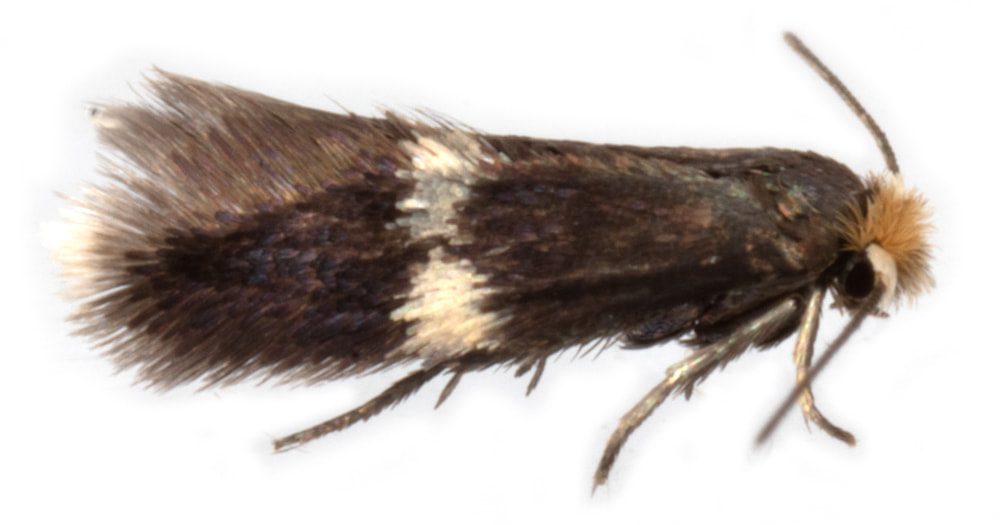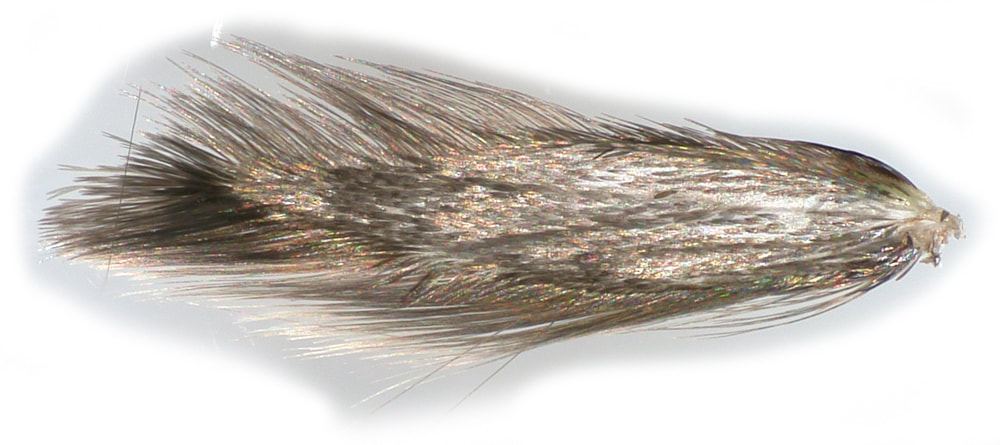04.099 Ectoedemia occultella (Large Birch Dot)
ws: 6-7mm (MBGBI1); May-Jun*; leaf-mine birch (Betula spp) Aug-Oct; common throughout GB
*Jun-Jul according to MBGBI1 - but this seems to be incorrect
*Jun-Jul according to MBGBI1 - but this seems to be incorrect
ID: Male head and collar blackish; female head and collar ferruginous yellow. Forewing black with violet reflections; whitish median fascia, sometimes broken in middle; cilia shining grey in male, pale yellow-grey in middle of termen in female. Genital dissection necessary to distinguish from similar species.
Male genitalia: Pseuduncus long and pointed > E.occultella/E.minimella. In E.occultella the cornuti are very short and triangular; in E.minimella they are long needles. In both species the aedeagus has a pair of apical teeth; it may be that in E.occultella these teeth have longitudinal ridges while in E.minimella the "teeth" are more pectinate.*
Female genitalia: signa fairly short; sclerite in ductus bursae with an anterior process and a small inward bulge in its posterior margin.
* In separating male E.occultella from E.minimella the following features may help: a) size - fw 2.3-3.2mm vs 2.3-2.7mm; b) frontal tuft with a little admixture of ferruginous vs without; c) forewing underside with a small elongate patch of narrow white scales along the costa vs without - but I doubt that any of these features is sufficiently reliable to avoid the need for genital determination.
Male genitalia: Pseuduncus long and pointed > E.occultella/E.minimella. In E.occultella the cornuti are very short and triangular; in E.minimella they are long needles. In both species the aedeagus has a pair of apical teeth; it may be that in E.occultella these teeth have longitudinal ridges while in E.minimella the "teeth" are more pectinate.*
Female genitalia: signa fairly short; sclerite in ductus bursae with an anterior process and a small inward bulge in its posterior margin.
* In separating male E.occultella from E.minimella the following features may help: a) size - fw 2.3-3.2mm vs 2.3-2.7mm; b) frontal tuft with a little admixture of ferruginous vs without; c) forewing underside with a small elongate patch of narrow white scales along the costa vs without - but I doubt that any of these features is sufficiently reliable to avoid the need for genital determination.
§1 Pound Wood, Essex; 02/06/2021; female; fw 3.4mm; to light
§2 Covert Woods, Kent; 09/05/2022; male; fw 3.2mm; to light
§3 Cliburn Moss, Cumbria; 11/06/2023; female; fw 3.0mm
All images © Chris Lewis
§2 Covert Woods, Kent; 09/05/2022; male; fw 3.2mm; to light
§3 Cliburn Moss, Cumbria; 11/06/2023; female; fw 3.0mm
All images © Chris Lewis
Page published 14/11/2021 (§1) | §2 added 09/06/2022 | §3 added 16/12/2023






























